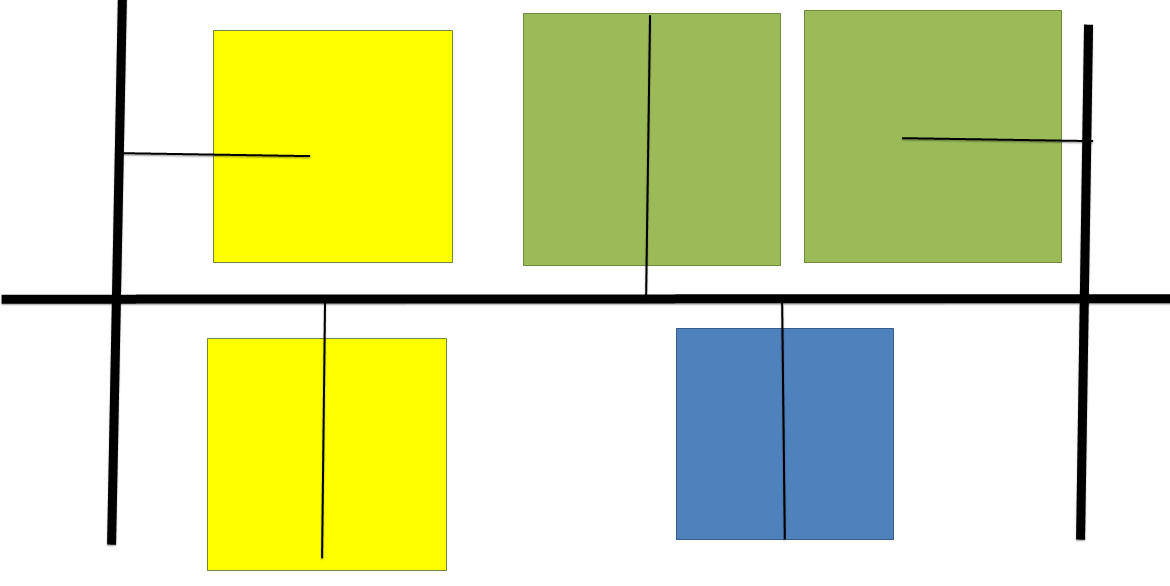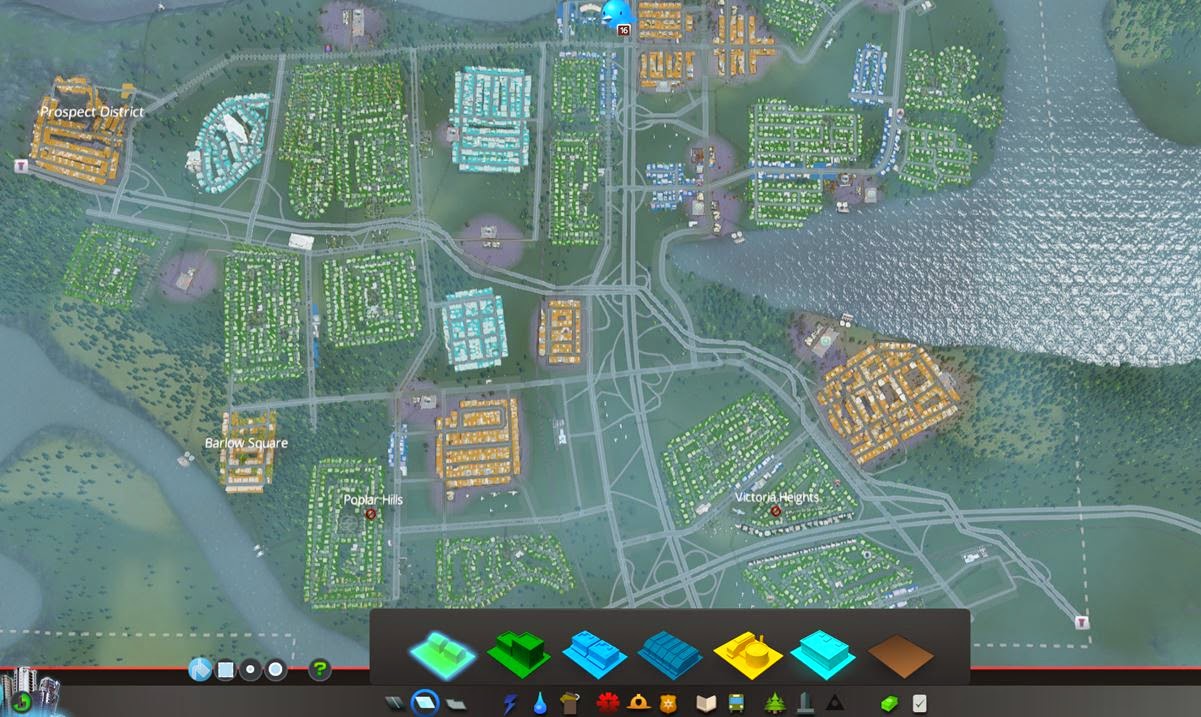So, all my free time is now gone since March 10. Why is that? Because Cities Skylines has been released. Not one week and I've already played 18 hours.
Cities Skylines is a city-builder in the vein of SimCity and Cities XL, but it stands out among the competition for having:
1- An agent-based engine that has every citizen in the city separately modeled, with a home, a job/school and some trips to leisure or commercial spots. Of course, the scale is quite off as a result, a 60 000 city in Skylines would probably have one or two million residents in real-life.
2- Transit options including bus, metro and train right out the door (not surprising considering this game is made by the makers of Cities in Motion 1 and 2, a transit-simulator game from which Cities Skylines is adapted)
The game uses zoning to shape the form of cities, with the player having to build public services like water mains, sewers and electricity generation. If you're at all interested in city simulation games, go get it, now.
More than just a game, Cities Skylines can help people understand urban and transport issues thanks to its basic characteristics. One of the main criticism leveled at SimCity was that it was a great game to build North American sprawl, and nothing else. Cities Skylines allows for the building of non-car-dependent cities.
It's not perfect, it doesn't have mixed used zoning, it doesn't have trams (present in Cities in Motion 2), it doesn't have bikes, it doesn't have transit-only lanes and the road builder is limited (you can't synchronize traffic lights, can't tell the game to have two-lane turning except in very specific situations, etc...).
Anyway, I've built two cities up to now, that I may call Transit City and Sprawlville.
Transit City: a bit of streetcar suburbs and of Japanese train station towns
The first city I built was intended from the get-go to be a dense, urban city, built around transit. To do so, I sought inspiration from streetcar suburbs and Japanese TOD towns built around train station.
 |
| Basic design of a streetcar suburb, grid of arterial (black lines), commercial/office is in blue, residential is in green, industrial is in yellow |
 |
| Train station town, inspired by examples in Japan |
The game also allows to zone for high-density housing or low-density housing, and low-density housing is needed to attract families. So I zoned the residential areas closest to commercial areas as high-density and kept low-density residential areas a bit farther out.
Here are some images of the city:
 |
| One of the difficulties of the game is managing traffic, but as you can see in this image down the main arterials, traffic is quite under control (industrial areas are another thing) |
These are two recent developments I've built around train stations outside the main city, who take after Japanese suburban cities built around train stations:
 |
| Garden City 1: train station is circled in red |
 |
| Garden City 2: again, the train station is circled in red |
Sprawlville: low-density, use separation, how developments occur nowadays
The second city I built was as a challenge. The city would be typical sprawl with extreme use separation. The main issue with something like this is traffic, how to manage it. The basic design here is to build each neighborhood in cul-de-sac, connecting to huge arterial streets and highways. Each neighborhood has a different use zoned for it, and connections between them outside of arterials are rare if not non-existent. That way, I can control traffic coming out of neighborhoods, if it's too much, I can remove some of it, and build another neighborhood farther away. In order to maintain fluidity on the arterials, there must be as few connections as possible.
 |
| Basic Sprawlville design, self-contained single-use neighborhoods connected to arterials |
 |
| Sprawl near Austin, TX. See how the main road a bit to the right of center on the image has no development on it, but has residential and industrial neighborhoods connected to it |
 |
| A few down the arterial street on the image above to prove that there is no development alongside it, or very, very few |
Now, let's see what it looks like from up high:
 |
| Sprawlville from the air, showing the different zones and the massive roads that connect them |
 |
| A zoom on some of the neighborhoods |
Analysis
Both of these cities are thriving according to the game. The Sprawlville design "works" in the game, as it does in reality. This design helps to dilute car traffic and to easily expand cities. Need more housing? Just build a new residential neighborhood. More industries? Open up a new industrial "park" somewhere. Let people find their way with cars between the neighborhoods.
The residents are "happy" in the game, in that they live in areas with no noise or air pollution. The game doesn't care about the health effects of such a design and the human and social consequences of it on individuals and communities. The point is: it works to absorb more residents and more jobs. Which is the entire point of the city-building game: to grow a city.
I've managed to grow the Transit City design also by planning the street grid and by building train stations in undeveloped areas to build "garden cities" around them. But this goes against everything we're used to doing in North America. Imagine, spending millions on transit lines to "nowhere"! Except that this "nowhere" soon becomes a thriving city thanks to an influx of people, shops and industries, and a city connected to an existing city with a high-capacity, high-speed transit line from the get-go.
Still, the game provides good lessons on this issue. Cities are growing all across the world, we have to find how to accommodate the population and the jobs inside the urbanized areas. But with the habits of "Development-Oriented Transit", of only building transit when density requires it, it is impossible to allow a city to grow around transit. Sure, you can densify older areas, but at one point, you reach a point when you no longer can, you need to build new areas outside the old city.
Expanding a city around cars and highways is easy. Sprawlville is an easy model to have, especially as you already have highways built, connecting regions together. Which provides a backbone for future developments. It also avoids having to review older neighborhoods. Once built, you leave them alone and move somewhere else. For urban planners, Sprawlville is exceedingly easy to plan, Transit City requires facing down opposition to densification or to massive public investment in transit.
Finally, an interesting point. If you don't know about Strong Towns, you're missing out. It's an American organization opposing sprawl on the grounds that sprawl is financially unsustainable and exceedingly wasteful. The organization is coming from a right-wing, fiscally conservative perspective, not really my cup of tea as a left-wing social-democrat, but let it not be said I'm not ready to listen to the other side.
Anyways, since the game has you planning and funding public services, it provides a demonstration of Strong Towns' main point about financial sustainability.
Look at the budgets for the two cities:
 |
| Transit City budget (60 000 population) |
 |
| Sprawlville budget (35 000 population) |
Transit City has an expenses budget of 167 000 C-dollars per game week, including nearly 25 000 in transit services and 44 000 in various optional policies (like free smoke detectors and subsidies).
Sprawlville has an expenses budget of 100 000 C-dollars per game week, with no transit nor optional policy in place.
By person, Transit City actually has 6% less expenses than Sprawlville, but if you take out the optional policies, Transit City residents actually incur 26% less expenses than Sprawlville residents... and if you remove transit expenses (which actually save residents money as they would need to buy cars otherwise, a factor not accounted for in the game), then Transit City's mode of development is 41% less expensive than Sprawlville's mode of development in terms of maintenance of public infrastructure AND less public services.
Of course, it's just a game, but a game based on micro models to simulate reality. This game demonstrates how the traditional mode of development, one based on density and public transit, is much more efficient than the sprawl. However, it also demonstrates why sprawl is winning in North America: sprawl is easy to plan for and makes it easier to grow cities without running in political conflicts. In other words, lazy urban planners, not economics, explain why sprawl is so dominant.

I'm still a big fan of SimCity 4 Deluxe/Rush Hour, with the Network Addon Mod of course. How would you say this compares as far as the fun factor? SimCity has never been good for real life modeling on a large scale, but it seems like a good enough balance between fun gameplay, traffic modeling, and aesthetic/civic city building.
ReplyDeleteI would say it is a very good balance between fun and realism. It's almost zen-like to make a city that works then look at the people going about their daily routine while demand for housing, shops and industries slowly increase, forcing you to expand the city somewhere.
DeleteI've never really played SimCity much. I do remember the SNES version, but at the time, my main fun was loading a fully built city then unleashing Godzilla and tornadoes on the residents.
I got my feet wet with the Super Nintendo version too. Outstanding music in that one, and in the franchise as a whole.
DeleteYou might be interested in the indie game Banished: it simulates growing a medieval-level group into towns and even cities (in scale if not in building style). The level of control is somewhere between The Sims and SimCity.
ReplyDeleteI don’t understand the hate of ppl owing a house. Not everyone likes the “city life”. Not everyone is a social butterfly and maybe you ppl should consider respecting ppl if they want PRIVACY. Living in an apartment is not privacy because if you make noise, ppl who live next to you will file for noise complaint and you will get evicted.
ReplyDeleteDo you underhand? That’s why ppl want to own a house. Because of PRIVACY. Because they want to live far away from ppl. Can you respect that?
I don’t understand why you city planners are trying to convince ppl that living in a city, renting an apartment is better than owning a house.
There should be more affordable houses, there is a big demand for it because ppl make less incomes and you city planners are more interested in building more apartments that NO ONE ASK because “urban is better than sprawl”.
Why is it such a big idea to force ppl to be social, maybe not everyone wants to be social. Can you respect that?
If ppl don’t like to live in cities, can you respect that? It has nothing to do with “maybe that’s because the metro is bad”.
If Tokyo is considered the best “urban” city, I would not live in it and I am not alone, I want to live as far away from ppl, away from cities, can you respect that?
I don’t understand the hate of single family houses.
I don't hate single-family houses. I hate the fact many suburban planners forbid the construction of anything else and that people who live in cities often have to subsidize the roads and infrastructure required to support a suburban lifestyle. If you want to live in a single-family house in the middle of nowhere, have at it, as long as you pay the full price of your decision and do not seek to forbid people who want to build other styles of housing.
Delete